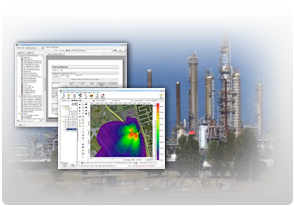Lakes Environmental e-Newsletter
In this issue:
- News & Events
- Upcoming Courses
- Modeling Tip: Calculating PM2.5 values in AERMOD
- Articles
- Upcoming Conferences & Trade Shows
News & Events
Lakes Environmental Releases CALRoads View™ Version 4.0
Lakes Environmental is pleased to announce the release of CALRoads View 4.0 on June 3, 2010.
Some of the new features include:
- Export to Google Earth™ - Export your modeling project to Google Earth to clearly envision your input data and results and dramatically improve communication
- New Project Wizard – takes you step-by-step through initial project setup options for creating a new project
 Please see the release notes for a complete list of the changes and new features available in CALRoads View Version 4.0.
Please see the release notes for a complete list of the changes and new features available in CALRoads View Version 4.0.
If you are currently in maintenance for CALRoads View and did not receive an email regarding this update, please contact us at support@weblakes.com.
If you are a user of CALRoads View but are no longer in maintenance please contact sales@weblakes.com to find out how you can get up and running on this latest release!
US EPA PM 2.5 Memorandum
On March 23, 2010, the US EPA Office of Air Quality Planning and Standards (OAQPS) released a memorandum discussing dispersion modeling procedures used to demonstrate compliance with the PM 2.5 National Ambient Air Quality Standards (NAAQS).
The memorandum states that when modeling either the initial Significant Impact Analysis or the Cumulative Impact Analysis, the following PM 2.5 averaging values should be calculated:
- Annual Standard: The highest average of the modeled annual averages across 5 years of National Weather Service (NWS) meteorological data or the highest modeled annual average for 1 year of site-specific meteorological data.
- 24-Hour Standard: The highest average of the maximum 24-hour averages across 5 years of NWS meteorological data or the highest modeled 24-hour average for 1 year of site specific meteorological data.
The memorandum is available at the US EPA web site. Please see below this month's modeling tip for details on how these values can be calculated in AERMOD.
New Knowledgebase for Lakes Environmental Freeware Products!
New Look, Easier Navigation, New Articles...
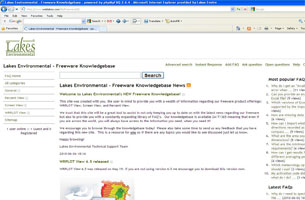 Lakes Environmental is proud to introduce our new Freeware Knowledgebase, which can be found on our web site. This knowledgebase will be dedicated to our current freeware product offerings: WRPLOT View, Screen View, and Percent View and will provide a wealth of information to the users of these tools.
Lakes Environmental is proud to introduce our new Freeware Knowledgebase, which can be found on our web site. This knowledgebase will be dedicated to our current freeware product offerings: WRPLOT View, Screen View, and Percent View and will provide a wealth of information to the users of these tools.
General information about each freeware product will be available as well a constantly expanding library of FAQ’s (Frequently Asked Questions). Our online knowledgebase is available 24/7/365 meaning that even those customers across the world will always have access to the information they need, when they need it. Try it out today!
Product Spotlight - FETS-RT Web™
FETS-RT Web (Facility Emissions Tracking System – Real Time) is a fully customizable,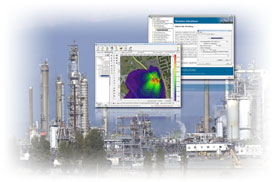 web-based software solution which allows facilities to monitor and model their air emissions in real-time.
web-based software solution which allows facilities to monitor and model their air emissions in real-time.
FETS-RT Web seamlessly interfaces with real-time monitoring equipment to alert the user of any observed concentrations which may exceed permitted thresholds. At the same time, FETS-RT Web provides continuous air dispersion modeling to predict when an exceedance might occur over the next 24 hours. FETS-RT Web uses a combination of real-time data from stack emission measurements, ambient monitoring stations, and meteorological station data in conjunction with forecast meteorology to run air dispersion modeling and determine the predicted impacts.
FETS-RT Web is a breakthrough environmental compliance solution allowing you to manage emergency scenarios, assist in demonstrating regulatory compliance, and perform culpability analysis. All of these functions can be performed using our dynamic, user-friendly interface which provides critical emissions and modeling information to operators, engineers, and site supervisors. These powerful capabilities make it possible for the first time to proactively evaluate mitigation strategies, evaluate alternate control options, and quantify potential off-site impacts up to 24 hours in advance.
Key Features:
- Pollutant impact forecasts generated every 5 minutes
- Air dispersion modeling performed using CALPUFF or SCIPUFF
- An intuitive ‘alarm system’ alerts users to any active or potential issues with concentration levels, forecasts, and data quality
- Comprehensive reports listing predicted meteorological conditions and potential impacts
- Graphing capabilities including displays of major source contributors to emissions and trend analysis
- Detailed graphics and animations displaying concentrations over your site region
- Ability to maintain unlimited model scenarios and startup conditions
FETS-RT Web is a unique and powerful software system that can be adapted to the specific requirements of your organization. Report functions and graphical displays can be tailored to your precise needs. Emission sources and model scenarios are configured to match the operating conditions of your site.
For more information or to schedule a web demonstration for you and your colleagues please contact sales@weblakes.com today!
We look forward to hearing from you!
AERMOD & CALPUFF Courses in the United Kingdom
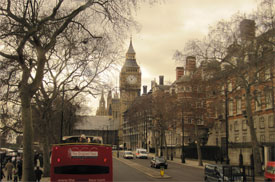
Lakes Environmental is pleased to be travelling to the United Kingdom for a week of AERMOD and CALPUFF training in London. We are proud to be a leading provider worldwide of powerful training for US EPA air dispersion models, with instructors being continuously rated as “outstanding” by course attendees.
We encourage you to register soon in order to reserve your spot. For further information including details of the course location and registration form please visit the Upcoming Courses section of our website.
Register today to take advantage of our early registration discount!
Lakes Environmental Closed For Canada Day Holiday
Lakes Environmental will be closed on Thursday, July 1, 2010 to observe the Canada Day holiday. If you have any pressing needs during that time, please e-mail us at support@weblakes.com and we will contact you on July 2, 2010 when our offices reopen.
Upcoming Courses
Date |
Course |
Location |
Registration |
Sept. 20-21, 2010 |
|||
Sept. 27-28, 2010 |
|||
Oct. 14-15, 2010 |
|||
Nov. 8-9, 2010 |
|||
Nov. 18-19, 2010 |
|||
Dec. 6-7, 2010 |
Hyderabad, India |
Registration Coming Soon! |
For more information on the above courses, including registration information, location, and course outlines, please visit our web site: https://www.weblakes.com/courses.html.
Modeling Tip
Calculating PM2.5 Values in AERMOD
The PM2.5 article above explains the National Ambient Air Quality Standards (NAAQS) modeling values used for PM2.5.
For the Annual Standard: the highest average of the modeled annual averages across 5 years of National Weather Service (NWS) meteorological data or the highest modeled annual average for one year of site-specific meteorological data.
For the 24-hour Standard: the highest average of the maximum 24-hour averages across 5 years of NWS meteorological data or the highest modeled 24-hour average for one year of site specific meteorological data.
These values can be calculated within AERMOD in the following way:
- Set the run period to one year
- Select Annual and 24-hour averaging period in the Control Pathway
- Select the 1st ranked value in the output pathway
- Run AERMOD
- Repeat steps 1-4 for the next 4 years of meteorological data (if using NWS data)
- For the Annual average, average together the 5 sets of results, and take the value from the receptor with the highest value
- For the 24-hour average, average together the 5 sets of results, and take the value from the receptor with the highest value
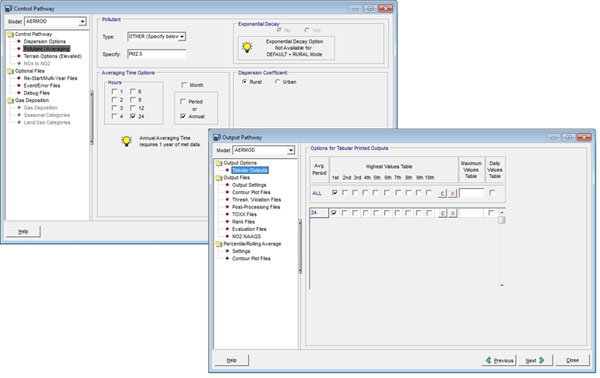
Note: The Annual average value could be calculated by running all 5 years at once with the Annual average selected, but the 24-hour average requires individual year-long runs.
Submit Your Modeling Tip Today!
We are currently accepting submissions for the Monthly Modeling Tip section that appears in our newsletters. If you have a modeling tip that may benefit our readers, please send it to us at support@weblakes.com. Your name and the name of your organization will appear below the tip providing you with an opportunity for increased exposure.
Articles
EPA Sets Stronger National Air Quality Standard for Sulfur Dioxide
WASHINGTON (June 3, 2010) - The U.S. Environmental Protection Agency (EPA) is issuing a final new health standard for sulfur dioxide (SO2). This one-hour health standard will protect millions of Americans from short-term exposure to SO2, which is primarily emitted from power plants and other industrial facilities. Exposure to SO2 can aggravate asthma and cause other respiratory difficulties. People with asthma, children, and the elderly are especially vulnerable to the effects of SO2.
Legal Battle Likely Over EPA Tailoring Rule
(May 26, 2010) - During the news conference to announce the U.S. EPA's final tailoring rule for GHG emissions thresholds from stationary sources, Assistant Administrator gina McCarthy, relayed the agency's confidence in its belief that the rule is legally sound. Industry sources and other legal experts, however, are not convinced, and it is expected that petitions challenging the rule will soon be filed.
Lawsuits are likely to focus on the EPA's authority to increase the emissions threshold established in the Clean Air Act. The CAA set a threshold of 100 or 250 tons per year of pollutants emitted from facilities, at which point they must obtain permits under the New Source Review Prevention of Significant Deterioration or Title V programs. When the EPA issued its endangerment finding on GHGs last December, it triggered the low threshold permitting requirements for GHG emissions beginning Jan. 2, which would result in a massive increase of permit requests. Therefore, in an attempt to relieve the administrative burden that those requirements would impose on permitting authorities, the EPA chose to tailor the threshold to increase the limit for GHG emissions and phase-in applicability for sources of GHG emissions.
EPA Adds More Than 6,300 Chemicals and 3,800 Chemical Facilities to Public Database Unprecedented Access Provided for the First Time
WASHINGTON (May 17, 2010) - As part of Administrator LIsa P. Jackson's commitment to increase public access to information on chemicals, the U.S. Environmental Protection Agency (EPA) has added more than 6,300 chemicals and 3,800 chemical facilities regulated under the Toxic Substances Control Act (TSCA) to a public database called Envirofacts.
"The addition to Envirofacts will provide the American people with unprecedented access to information about chemicals that are manufactured in their communities," said Steve Owens, assistant administrator for EPA's Office of Chemical Safety and Pollution Prevention. "This is another step EPA is taking to empower the public with information on chemicals in their communities."
Canada Announces Continental Approach to Reduce GHG Emissions from Heavy-Duty Vehicles
VANCOUVER (May 21, 2010) - Today, the Honourable Jim Prentice, Minister of the Environment, announced that the Government of Canada will regulate greenhouse gas emissions from new heavy-duty vehicles under the Canadian Environmental Protection Act, 1999. Canada's regulations will be aligned with those of the United States.
"Canada and the United States had great success in establishing common standards for regulating greenhouse gas emissions from passenger automobiles and light trucks," said Minister Prentice. "Building on our strong working relationship with the Obama administration, we are taking the next logical step by addressing emissions from heavy-duty vehicles."
Upcoming Conferences & Trade Shows
Date |
Conference |
Location |
Jun. 22-25, 2010 |
A&WMA 103rd Annual Conference and Exhibition |
Calgary, AB, Canada |
Aug. 10-12, 2010 |
6th Australia-New Zealand Climate Change & Business Conference |
Sydney, Australia |
Aug. 30-Sept. 2, 2010 |
Power Plant Air Pollutant Control "MEGA" Symposium |
Baltimore, MD, USA |
Sept. 12-16, 2010 |
15th International Union of Air Pollution Prevention and Environmental Protection Associations' (IUAPPA) World Clean Air Congress |
Vancouver, BC, Canada |
Sept. 27-30, 2010 |
19th International Emissions Inventory Conference |
San Antonio, Texas, USA |
Oct. 25-26, 2010 |
Climate Change and Impact Assessment |
Aalborg, Denmark |
Oct. 27-28, 2010 |
Carbon Forum Asia |
Singapore |
Nov. 2-4, 2010 |
Symposium on Air Quality Measurement Methods and Technology |
Los Angeles, CA, USA |
Nov. 7-11, 2010 |
SETAC North America 31st Annual Meeting |
Portland, OR, USA |
Nov. 16-18, 2010 |
GHG Solutions Conference & Expo |
Pittsburgh, PA, USA |
About this Newsletter
This newsletter contains information gleaned from various sources on the web, with complete links to the sources cited. Organizations cited are in no way affiliated with Lakes Environmental Software.
Lakes Environmental Software is a leading environmental IT company that offers a complete line of air dispersion modeling, risk assessment, emissions inventory, and emergency release software as well as training and custom software services. With satisfied users located around the globe, Lakes Environmental Software will continue to revolutionize the environmental software field.
For more information please visit our web site at: www.weblakes.com. You may also contact us by phone at (519) 746-5995 or by fax at (519) 746-0793.
All comments and suggestions are welcome. You can e-mail us at: support@weblakes.com.
Please click the link below to subscribe or unsubscribe from this newsletter:
Subscribe/Unsubscribe


